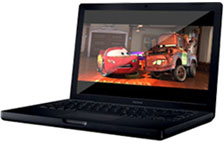 These links provide a quick way to access hardware profile indexes for PowerPC-based Macs on Low End Mac.
These links provide a quick way to access hardware profile indexes for PowerPC-based Macs on Low End Mac.
![]()
The 13.3″ widescreen MacBook was intended as a replacement for both the 12″ iBook G4 and the 12″ PowerBook G4, although those who appreciated the compact size of the 12″ ‘Books continued to hope for MacBook with a smaller footprint.

The MacBook originally shipped in white and black, and it had an unusual keyboard at the time. Although it looks like the “chiclet” keyboards found on many cheap computers in the early days of personal computing, most who spent any time working with the MacBook found it an excellent keyboard.
New to the MacBook in comparison to the 12″ models it replaced are built-in iSight, a glossy screen, and support for extended desktop mode (not officially supported with iBooks, although long a PowerBook feature). The MacBook uses the same MagSafe power connector and power supply as the MacBook Pro line.
One useful new feature is auto-unmute (for lack of a better name). If your MacBook’s volume is set on mute and you plug in headphones, it immediately turns on the volume. And it mutes as soon as you unplug the headphones.
There was quite a bit of controversy over the MacBook’s glossy, reflective screen from the very beginning, but such screens have long been the norm in the Windows notebook realm – and Apple’s implementation seems to be better than the bulk of them. Also note that the MacBook’s screen displays 18-bit color, not the full 24 bits you might expect.
The MacBook initially used integrated Intel GMA 950 graphics, which offers far less performance than the ATI and Nvidia graphics found in iBooks, PowerBooks, MacBooks Pros, and all but the low-end Intel-based iMacs. 80 MB of system RAM is tied up by the GMA 950 graphics processor and unavailable to applications.
Like the other Macintel models, the MacBook shipped with Front Row and a remote control.
AirPort Extreme and Bluetooth 2.0 are standard features. Until Apple simplified the line in October 2008, the entry-level MacBook shipped with a Combo drive, while the top-end models included a SuperDrive.
Online Resources
- Is More RAM More Important Than Matched RAM?, Dan Knight, Mac Musings, 2007.05.25. Other World Computing has benchmarked 15 configurations with six programs and concluded that more memory is better than matched modules. Are they right?



